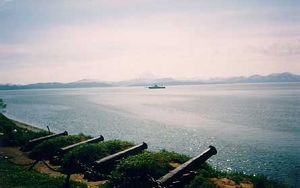Siege of Petropavlovsk: Difference between revisions
→French: +section +image |
→References: +book |
||
| Line 70: | Line 70: | ||
* [http://www.pdavis.nl/Russia2.htm W.L. Clowes on the 1854-56 Russian War] |
* [http://www.pdavis.nl/Russia2.htm W.L. Clowes on the 1854-56 Russian War] |
||
* [http://www.hms-trincomalee.co.uk/historic/navy/service.htm HMS ''Trincomalee'' - Royal Navy Service] |
* [http://www.hms-trincomalee.co.uk/historic/navy/service.htm HMS ''Trincomalee'' - Royal Navy Service] |
||
* [http://books.google.com/books?id=-CIPAAAAYAAJ Russia on the Pacific and the Siberian railway] By Vladimir, Zenone Volpicelli, S. Low, 1899 p.224 |
|||
==External links== |
==External links== |
||
Revision as of 23:12, 24 July 2010
This article needs additional citations for verification. (July 2010) |
| Siege of Petropavlovsk | |||||||
|---|---|---|---|---|---|---|---|
| Part of Crimean War | |||||||
 Cannons which were used to defend Petropavlovsk in 1854. | |||||||
| |||||||
| Belligerents | |||||||
|
|
| ||||||
| Commanders and leaders | |||||||
|
|
| ||||||
| Strength | |||||||
|
2,600 men 218 cannons 6 warships: |
920 men 67 cannons warships: frigate Aurora (44) transport Dwina (12) | ||||||
| Casualties and losses | |||||||
| 500 dead |
100 dead 2 ships: commercial vessel Avatska transport Sitka (10) | ||||||
The Siege of Petropavlovsk was the main operation on the Pacific Theatre of the Crimean War. The Russian casualties are estimated at 100 soldiers; the Allies lost five times as many.
In the China and Japan seas, at the beginning of the war, the Russian Rear-Admiral Yevfimy Putyatin had under his orders the Pallada, 60 guns, Aurora, 44, and Dvina, 12. The British force on the station was under Rear-Admiral David Price (newly-promoted after serving as post captain for 39 years) and the French under Rear-Admiral Auguste Febvrier-Despointes. In total Allied fleet had nine ships and over 200 cannons. Putyatin was, of course, helpless at sea against such a force; and therefore he sent the Pallada far up the river Amur, and utilised her people in reinforcing the weak garrisons on the littoral. The Aurora and Dvina took refuge in Petropavlovsk, a post against which it was foreseen that the allies would probably attempt operations. Price and Febvrier-Despointes, after having detached the Amphitrite, Artémise, and Trincomalee to cruise for the protection of trade off the coasts of California, went in search of the Russians, and, on August 28th, sighted the shores of Kamchatka.
The siege
The siege started on 18 August 1854, when an Allied squadron of three British and French frigates, one corvette, one brig and one steamship cast anchor in the Avacha Bay. The Allied forces far outnumbered the Russians, and the main Russian vessel, the 60-gun Pallada, was sent far up the River Amur out of harm's way. The remaining forces led by Rear Admiral Putyatin took refuge in the harbour of Petropavlovsk on the Kamchatka peninsula, defended by its shore batteries. Aurora was anchored behind a sand spit topped by a shore battery.
The Allied force, commanded by Rear Admirals Febvrier-Despointes and Price advanced to bombard Petropavlosk on 30 August 1854. They had some 218 cannons at its disposal, as compared to 67 cannons available to the defenders of Kamchatka's main city under Vasily Zavoyko. Almost immediately, Price went below decks and shot himself. The Allies withdrew, but returned to resume the bombardment the next day, 31 August, with Captain Nicolson of HMS Pique in temporary command.
Petropavlovsk was lightly defended, with just over 1,000 troops, including the crews of the vessels sheltering in its harbour. The Allied squadron re-entered Avacha Bay to storm the city. A Naval Brigade of around 700 British and French seamen and marines landed on 4 September, under Captains Burridge and de La Grandiere, but they were ambushed and, after some heavy fighting, retreated with 107 British and 101 French dead or wounded. On 24 August, 970 Allied troops landed west of Petropavlovsk, but were repelled by 360 Russians.
The Allies withdrew, although President and Virago managed to capture the Russian Anadis, a small schooner, and the 10-gun transport Sitka on 7 September 1854. The Allies left Petropavlovsk to the Russians until April 1855, when Nikolay Muravyov, aware of the insufficiency of troops and weapons to repel another attack on the city, had Petropavlovsk garrison evacuated under the cover of snow.
Allied fleet
British
The British force on the station was under Rear-Admiral David Price, and consisted of:
- HMS President, 50-gun frigate (flagship), Captain Richard Burridge
- HMS Pique, 40, fifth-rate frigate, Captain Sir Frederick William Erskine Nicolson, Bart.,
- HMS Trincomalee, 24, Leda-class frigate, Captain Wallace Houstoun
- HMS Amphitrite, 24, Leda-class frigate, Captain Charles Frederick,
- HMS Virago, 6, paddle steamer, Commander Edward Marshall
French
The French Rear-Admiral Auguste Febvrier-Despointes had at his disposal:
- Forte, 60 (flagship)
- Eurydice, 30
- Artémise, 30
- Obligado, 18.
Gallery
-
The map of allied attack on Petropavlovsk, Kamchatka, 1854
-
The Russian frigate Pallada
-
The HMS President was built to the plans of the USS President
-
The British flag, taken in battle August 24, 1854.
References
- M.A. Sergeyev. Defense of Petropavlovsk-on-the-Kamchatka. 3rd ed. Moscow, 1954.
- Chapter in the Crimean War, by Yevgeny Tarle.
- W.L. Clowes on the 1854-56 Russian War
- HMS Trincomalee - Royal Navy Service
- Russia on the Pacific and the Siberian railway By Vladimir, Zenone Volpicelli, S. Low, 1899 p.224
External links



